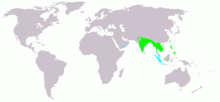Pheasant-tailed jacana
| Pheasant-tailed jacana | |
|---|---|
_I_IMG_8638.jpg) | |
| In non-breeding plumage at Bharatpur, Rajasthan, India | |
| Scientific classification | |
| Kingdom: | Animalia |
| Phylum: | Chordata |
| Class: | Aves |
| Order: | Charadriiformes |
| Family: | Jacanidae |
| Genus: | Hydrophasianus Wagler, 1832 |
| Species: | H. chirurgus |
| Binomial name | |
| Hydrophasianus chirurgus (Scopoli, 1786) | |
 | |
_I2_IMG_8639.jpg)
The pheasant-tailed jacana (Hydrophasianus chirurgus) is a jacana in the monotypic genus Hydrophasianus. Jacanas are a group of waders in the family Jacanidae that are identifiable by their wide feet and claws which enable them to walk on floating vegetation in shallow lakes, their preferred habitat. The pheasant-tailed jacana is capable of swimming, although it usually walks on the vegetation. The females are more colourful than the males and are polyandrous.
For the origin and pronunciation of the name, see Jacana.
Distribution
The pheasant-tailed jacana breeds in India, southeast Asia, and Indonesia. It is sedentary in much of its range, but northern breeders from south China and the Himalayas migrate into peninsular India and southeast Asia. It is also resident in Taiwan, where it is considered endangered. It has been recorded as a vagrant in Australia.
Description
-_Breeding_in_Hyderabad%2C_AP_W_IMG_7623.jpg)
This is the only jacana to have a different breeding plumage. The pheasant-tailed jacana is conspicuous and unmistakable. It is around 39–58 cm (15–23 in) in length, about 25 cm (9.8 in) of which is comprised by the pheasant-like tail.[2] Body mass is reportedly 113–135 g (4.0–4.8 oz) in males and 205–260 g (7.2–9.2 oz) the larger females.[3] The outermost primaries have a spatulate extension of 2 cm and the seventh primary has a broad protrusion.
Breeding adults are mainly black other than white wings, head, and fore neck. The hind neck is golden. There is a striking white eyestripe. The legs and very long toes are grey. Non-breeding adults lack the long tail. The underparts are white except for a brown breast band and neck stripe. The side of the neck is golden. Young birds have brown upperparts. The underparts are white, with a weak brown breast band.
Measurements (From Rasmussen and Anderton): length 310 mm 390–580 mm (breeding) Wing (with extension of primary) 190–244 mm (adults) 168–228 mm (juveniles) Bill 23–30 mm Tarsus 45–58 mm Tail 194–376 mm (breeding) 110–117 mm (non breeding)
Breeding
These jacanas breed on floating vegetation from March to July. In southern India, it breeds in the monsoon season, June–September. They are polyandrous and a female may lay up to 10 clutches. Four black-marked brown eggs are laid in the floating nests.
Habits
The pheasant-tailed jacana's main sources of food are insects and other invertebrates picked from the floating vegetation or the water's surface.
Their call is a mewing me-onp and a nasal teeun.
In zoos
Zoo Miami has had the pheasant-tailed jacana on display.
References
- ↑ BirdLife International (2012). "Hydrophasianus chirurgus". IUCN Red List of Threatened Species. Version 2013.2. International Union for Conservation of Nature. Retrieved 26 November 2013.
- ↑ (2011).
- ↑ CRC Handbook of Avian Body Masses by John B. Dunning Jr. (Editor). CRC Press (1992), ISBN 978-0-8493-4258-5.
- Shorebirds by Hayman, Marchant and Prater ISBN 0-395-60237-8
- Rasmussen, P. and J. Anderton (2005) Birds of South Asia - the Ripley guide. Smithsonian and Lynx edicions.
Habits, behavior, plumage
-
_at_Purabasthali_I_IMG_1569.jpg)
Landing (in non-breeding plumage) on Floating vegetation at Purbasthali in Bardhaman District of West Bengal, India.
-
_at_Purabasthali_I2_IMG_1575.jpg)
Resting (in non-breeding plumage) on Floating vegetation at Purbasthali in Bardhaman District of West Bengal, India.
-
-_chicks_in_an_Indian_Lotus_(Nelumbo_nucifera)_Pond_in_Hyderabad%2C_AP_W_IMG_7634.jpg)
Chicks in an Indian Lotus Nelumbo nucifera Pond in Hyderabad, India.
-
-_Breeding_with_chicks_in_an_Indian_Lotus_(Nelumbo_nucifera)_Pond_in_Hyderabad%2C_AP_W_IMG_7627.jpg)
Breeding- with chicks in an Indian Lotus Nelumbo nucifera Pond in Hyderabad, India.
-
-_Breeding-_shaking_off_after_bath_in_an_Indian_Lotus_(Nelumbo_nucifera)_Pond_in_Hyderabad%2C_AP_W_IMG_7871.jpg)
Breeding- shaking off after bath in an Indian Lotus Nelumbo nucifera Pond in Hyderabad, India.
-
-_Breeding-_preening_after_bath_in_an_Indian_Lotus_(Nelumbo_nucifera)_Pond_in_Hyderabad%2C_AP_W_IMG_7883.jpg)
Breeding- preening after bath in an Indian Lotus Nelumbo nucifera Pond in Hyderabad, India.
-
-_Breeding-_preening_after_bath_in_an_Indian_Lotus_(Nelumbo_nucifera)_Pond_in_Hyderabad%2C_AP_W_IMG_7880.jpg)
Breeding- preening after bath in an Indian Lotus Nelumbo nucifera Pond in Hyderabad, India.
-
-_Breeding-_preening_after_bath_in_an_Indian_Lotus_(Nelumbo_nucifera)_Pond_in_Hyderabad%2C_AP_W_IMG_7876.jpg)
Breeding- preening after bath in an Indian Lotus Nelumbo nucifera Pond in Hyderabad, India.
-
-_Breeding_in_Hyderabad%2C_AP_W_IMG_7612.jpg)
Breeding- in Hyderabad, India.
-
-_Breeding_in_an_Indian_Lotus_(Nelumbo_nucifera)_Pond_in_Hyderabad%2C_AP_W_IMG_7860.jpg)
Breeding- in an Indian Lotus Nelumbo nucifera Pond in Hyderabad, India.
-
-_Breeding_in_an_Indian_Lotus_(Nelumbo_nucifera)_Pond_in_Hyderabad%2C_AP_W_IMG_7629.jpg)
Breeding- in an Indian Lotus Nelumbo nucifera Pond in Hyderabad, India.
-
-_Breeding_in_an_Indian_Lotus_(Nelumbo_nucifera)_Pond_in_Hyderabad%2C_AP_W_IMG_7575.jpg)
Breeding- in an Indian Lotus Nelumbo nucifera Pond in Hyderabad, India.
-
-_Breeding-_bathing_in_an_Indian_Lotus_(Nelumbo_nucifera)_Pond_in_Hyderabad%2C_AP_W_IMG_7865.jpg)
Breeding- bathing in an Indian Lotus Nelumbo nucifera Pond in Hyderabad, India.
-
-_Breeding-_after_bath_in_an_Indian_Lotus_(Nelumbo_nucifera)_Pond_in_Hyderabad%2C_AP_W_IMG_7877.jpg)
Breeding- after bath in an Indian Lotus Nelumbo nucifera Pond in Hyderabad, India.
-
-_Breeding-_after_bath_in_an_Indian_Lotus_(Nelumbo_nucifera)_Pond_in_Hyderabad%2C_AP_W_IMG_7874.jpg)
Breeding- after bath in an Indian Lotus Nelumbo nucifera Pond in Hyderabad, India.
-
_in_Kolleru%2C_AP_W_IMG_3901.jpg)
in Kolleru Lake, Andhra Pradesh, India.
-
_in_Kolleru%2C_AP_W_IMG_3871.jpg)
in Kolleru Lake, Andhra Pradesh, India.
-

Jacana in flight at Sholinganallur swamp Sholinganallur, Chennai, Tamil Nadu, India
| Wikimedia Commons has media related to Hydrophasianus chirurgus. |
